Pseudobiceros gratus (Kato, 1937)Brown strip flatworm
CLICK TO NAVIGATE SITE
|
|
|
Introduction
Back to top
Pseudobiceros gratus belong to the Pseudobiceros planarian flatworms which form part of the marine polyclads.
Table of Contents
Simple but elegant these animals exhibit bilateral symmetry and are one of the few polyclads with a white body wall donning brown strip(s) on its dorsal side. Like all marine polyclads, in the Pseudobiceros genus, P. gratus are hermaphrodites with both male and female reproductive organs which are known as gonopores. As compared to individuals from its sister genus, Pseudoceros, individuals from Pseudobiceros have not one but two male reproductive organs. P. gratus exhibits an interesting behaviour during copulation and a video showing this can be below in the Biology section. P. gratus has been described and photographed in both southern and northern shores of Singapore. It has been described to be "seasonal" with multiple sightings within a short time period followed by little or no sightings.[1] It is known here in Singapore as the brown strip flatworm.
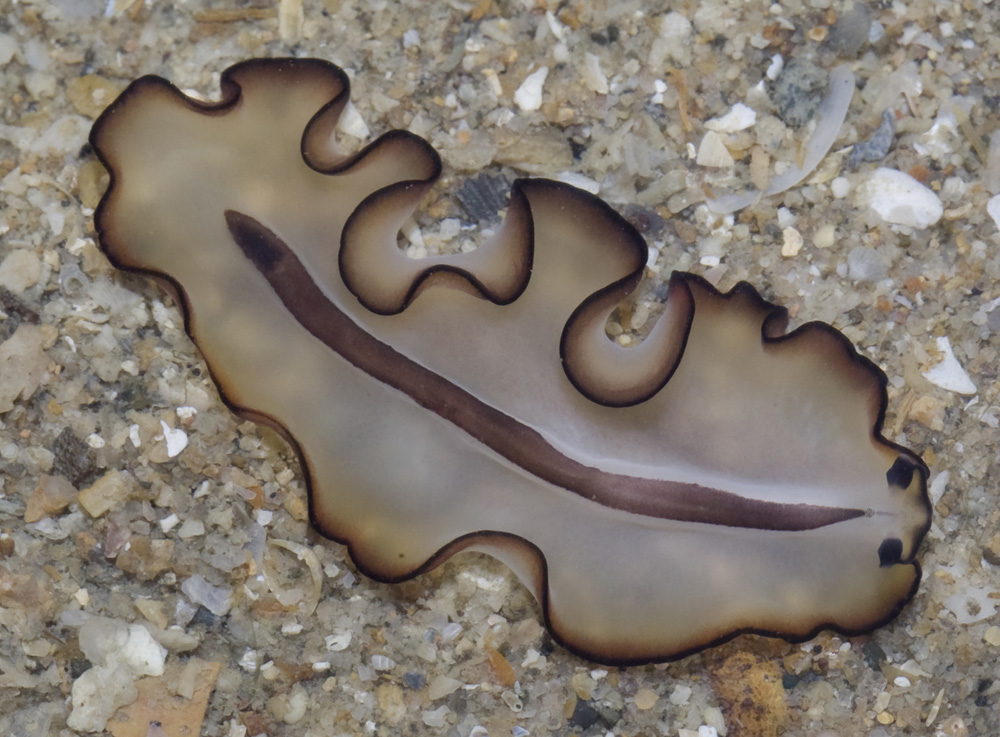 |
| Courtesy of Ria Tan (c) editor for WildSingapore.com |
Name
Back to top
It is common for animals to have both a scientific name (Binomial name) and a common name (Vernacular name) and this is no different for P. gratus. The authority for the name Kojiro Kato, gave the species epithet: gratus, a latin word for gratitude so as to express his feelings of gratitude to his friend, Mr. J Ishida, who found the original specimen on top of a stone in the tidal zone in front of the Mitsui Institute of Marine before it was presented to him.[2]
| Binomial name |
Pseudobiceros gratus (Kato, 1937)[2] |
| Vernacular Name |
Brown strip flatworm |
| Etymology |
The species epithet, gratus, was based off the latin word gratus, which was derived from the Proto-Indo-European root **gwere-** (which means to gratitude). |
| Latin definition: |
gratus adj. masculine (feminine grata,neuter gratum)
|
Taxonomic History
Below are the scientific names Pseudobiceros gratus took before finally settling with its current name. Previously, Pseudobiceros gratus was placed under the genus Pseudoceros but was shifted to Pseudobiceros due to the difference in the number of male gonopores.
- Eurylepta striata (Schmarda, 1859): 27-28 fig. 62.[3]
- Pseudoceros striatus (Schmarda, 1859) Stummer-Traunfels, 1933: 3487, 3540, 3544 figs, 95, 96. [4]
- Pseudoceros gratus (Kato, 1937): 227-229; [2]
- Pseudoceros strigosus (Marcus, 1950): 88. [5]
- Pseudoceros habroptilus (Hyman, 1959): fig 8.[6]
- Pseudobiceros strigosus (Marcus, 1950) Faubel, 1984: 21[7]
- Pseudobiceros gratus (Kato, 1937): Poulter, 1987: 46 pl. 2.I.2.d; Newman & Cannon, 1994a:248- 249, figs. 38a-d [11]
Distribution
Back to top
Pseudobiceros gratus have been spotted in the Ceylon/Sri Lanka, Japan, Micronesia, Hawaii, the Great Barrier Reef of Australia (Heron and One Tree Island), Madang in Papua New Guinea and Singapore(Pulau Semakau, Sister Islands, Pulau Hantu, Chek Jawak, Pulau Ubin, Pulau Sekudu, Changi) [13]
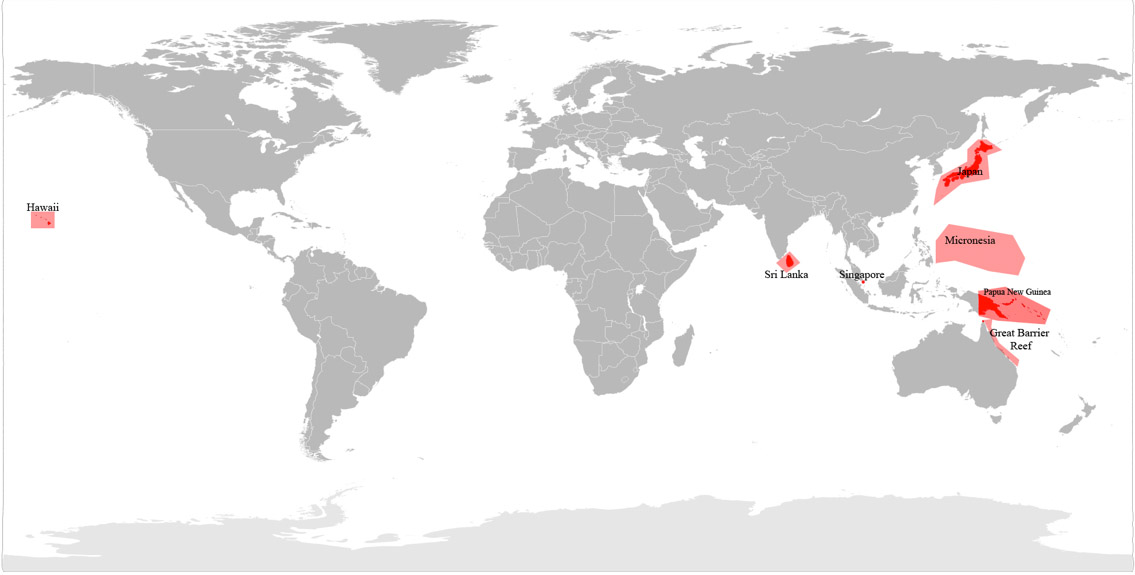
Exact Locations
Biology
Back to top
Feeding habits
The biology of Pseudobiceros gratus, is similar to other marine polyclads. P. gratus are important predators of benthic invertebrates such as ascidians, crustaceans and molluscs, including all commercial bivalve species using a protrusible pharynx called the folded plicate pharynx also present in triclads and proseriates.Reproduction: Penis Fencing(VIDEO)
Flatworms have both male and female sex organs in the one animal.If you think about it, that's a great way to be.
If you're rare and you're looking for a mate and you're traveling alone,
you don't have to meet another female or another male.
You just have to meet another one. -- Leslie Newman
Despite being hermaphrodites and having both male and female sexual reproductive organs, individuals of the species P. gratus do participate in sexual reproduction. During copulation, individuals engage in "penis fencing", a term used to describe the copulatory behaviour exhibited by the flatworms as they attempt to inject and inseminate each other with their own sperm through the body wall. The individual inseminated will then bear the burden of "motherhood". Such a reproductive model is thought to be unlikely in generating elaborate morphological copulatory isolating mechanisms thus providing a convincing explanation for the relative reproductive homogeneity in these flatworms.[10] Shown below is a video on "penis fencing".
Note: The flatworm species found in the video is not P. gratus however the reproductive behaviours are similar.
Habitat
Pseudobiceros gratus are known to be found near corals reefs hiding under rock boulders.Locomotion (VIDEO)
Being animals without appendages, P. gratus relies on dorsoventral undulations of the lateral body margins to propel itself. [10]Courtesy of Andy Dinesh. The video was taken at Labrador Park in 2007[8]
Diagnosis
Back to top
P. gratus has a white body, with three or four black longitudinal stripes on the dorsal side, ventral side is white. A black rim surrounds the margin of the animal. At the anterior end, ear-like pseudotentacles can be found which black with white tips. [11] The subspecies found here in Singapore has only one longitudinal strip running along the median line and has been confirmed to be Pseudobiceros gratus by Leslie H. Harris of the Natural History Museum of Los Angeles County
Description
Back to top
External anatomy
Deep marginal ruffles run along the sides of the body of P. gratus. The body has a white or cream background. The dorsal side has three or four dark longitudinal stripes with either one or two running along the median line.[9] A black rim surrounds the body. The ventral side is transparent white circumvented with a narrow black rim and found in the center is a long and narrow pharynx with simple folds. The body is raised along the longitudinal median line. A small cerebral cluster with numerous eyespots can be found near the anterior end of the animal along with pointed ear-like pseudotentacles (rollover image below) which are black in colour with white tips and numerous eyes close to the margin.[9]
 |
| Figure 1 Newman, L. J. & L. R. G. Cannon, 1994a. Fig. 38 [10] . Reproduced with permission from the Queensland Museum |
Internal anatomy:
The male complex consists two male gonopores, hence '-biceros' for the two horns which are the male gonopores, each of which leads to an independent male system. Each system consists of a branched vas deferens, a rounded oblong seminal vesicle connected to a long and coiled ejaculatory duct, an oval prostatic vesicle and a small stylet housed in a deep antrum. The female system consists of a deep antrum and a short vagina surrounded by the cement glands.
Original Description by Kojiro Kato, 1937 (Originally published in English) [2]
‛In the living state, the body is of a leaf-like shape with a strongly frilled margin and measures 50 mm long by 25 mm broad at the widest part.
The dorsal side is milky white and is marked with three black bands, a median and a pair of lateral along the entire body length. The two lateral bands are continuous with each other at the posterior end of the body. In addition to these bands, the body is completely bordered by a narrow black stripe, gradually shading inward to milky white. The ventral side is also milky white.
A large number of the eye-spots are distributed as usual on the tentacular folds in two clusters of a triangular shape. In a clear space at the base of the tentacular folds are the cerebral eye-spots indistinctly divided into two groups.
A sucker is situated at the centre of the body. The mouth lies closely behind the brain at about the anterior sixth of the body. The intestinal branches form a network. The epidermis is composed of columnar cells, containing numerous rhabdites and black pigments just mentioned.
This planarian has a paired male genital organs closely situated on both sides of the median line as observed in several Pseudoceros species such as P. bedfordi, nigromarginata and luteomarginata. The seminal canal, one on either side, proceeds forward to the level slightly behind the female genital pore, and passes anteriorly into the wide seminal vesicle of a crescent shape with a well-developed muscular wall. The seminal vesicle is narrowed ventrally to form a slender ejaculatory duct which runs pursuing anteriorly a sinuous course and after receiving the duct of the prostate gland at the base of the penis, opens at the tip of the latter. The small pyriform prostate lie just in front of the penis and has a thick muscular wall which is pierced with numerous efferent ducts of the extracapsular gland. The penis is a chitinous stylet of a wavy outline and subvertically disposed in the penis sheath. The antrum masculinum forms an oblique anteriorly directly annular outbuldging before it opens externally at the hind limit of one-third of the body.
A female genital pore lies closely behind the male pore. The arrangement of the female genital organs is much similar to that found in other species of this genus.
The present species differs distinctly from all other members of Pseudoceros in the peculiar colour markings
as well as in the anatomical details of the male genital organs.’
Phylogenetics
Back to top
Using DNA 'characters' obtained from the DNA sequences collected species found within the Pseudocerotidae family, Dr Litvaitis, M. K. has successfully reconstructed a phylogenetic tree for the Pseudocerotidae family. Based on the data, Pseudobiceros was found to be paraphyletic excluding the Thysanozoon unlike the Pseudoceros which was found to be a monophyletic. [11]
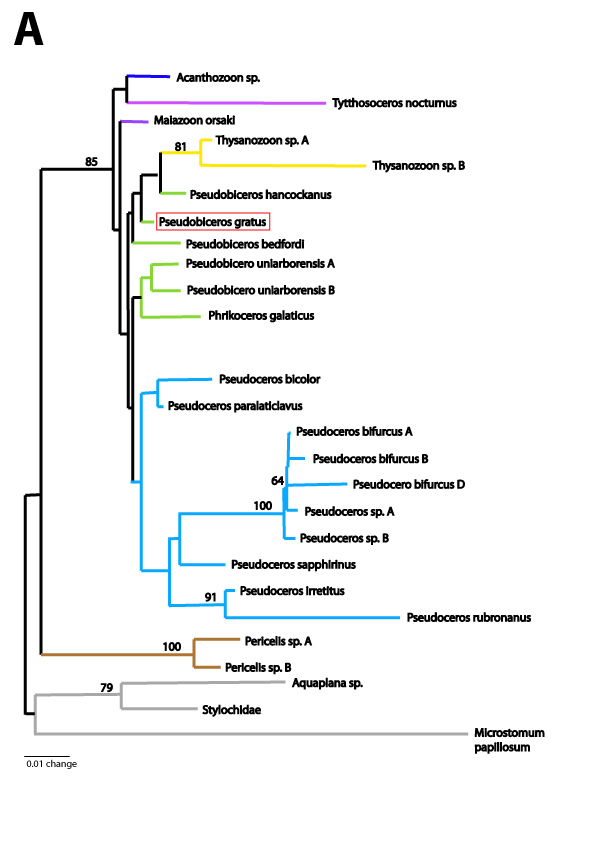 |
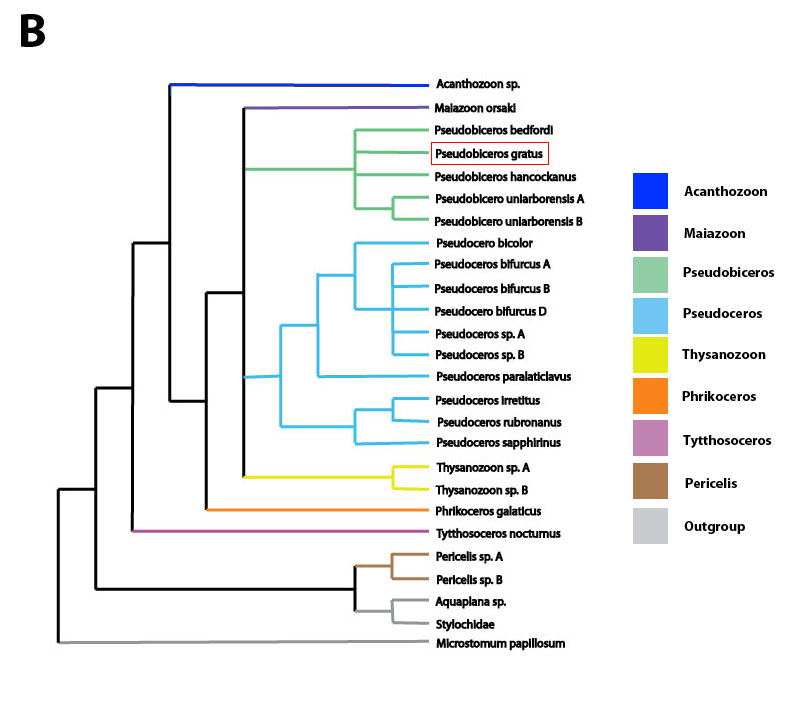 |
| Figure 2 Phylogenetic Analysis of nucleotide sequences belonging to the D3 expansion segment of the 28S rDNA gene fom species Pseudocerotidae family which Pseudobiceros gratusfalls under. The sequences were machine aligned using the CLUSTAL method in the MegAlign software and later manually adjusted. (A) Neighbour Joining (NJ) Tree generated from multiple sequence alignment. Reliability of the internal nodes was ascertained by 2000 bootstrap replications and only values above 50% is reported. (B) Maximum parsimonous Tree with Pseudobiceros confined a monophyletic group Figures were redrawn based upon those found in Litvaitis, M. K., and L. J. Newman. 2001. A molecular framework for the phylogeny of the Pseudocerotidae (Platyhelminthes, Polycladida). Hydrobiologia 444 (1-3):177-182 fig. 1 & 2 |
Type Information
Back to top
The location of the type material was not mentioned in the original paper but there is a whole mount (QMG210361) and a set of serial histological sections (QMG210566) deposited at the Queensland Museum in Brisbane, Australia.[9][12]
Taxonavigation
Back to top
Found within the animalia kingdom in the tree of life, Pseudobiceros gratus belongs to the phylum of Platyhelminthes in the class Tuberllaria (flatworms) which consists of free-living worms like P. gratus and also parasitic worms such as flukes and tapeworms.
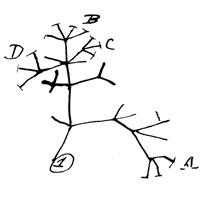 |
| One of the first known sketches of an evolutionary tree by Charles Darwin describing the relationships among groups of organisms |
-----Kingdom :Animalia
------Phylum :Platyhelminthes
-------Class :Tubellaria
--------Order :Polycladida (Lang, 1884) [13]
---------Suborder :Cotylea (Lang, 1884)
----------Family :Pseudocerotidae (Lang, 1884)
-----------Genus :Pseudobiceros (Faubel, 1984)
------------Species :Pseudobiceros gratus (Kato, 1937)
Literature and References
Back to top
- ^ http://www.wildsingapore.com/wildfacts/worm/polycladida/gratus.htm
- ^ Kato, K., 1937. Polyclads collected in Idu, Japan. Japanese Journal of Zoology 7: 227 - 229
- ^ Schumarda, L. K., 1859. Neue wirbellosen Thiere beobachtet and gesammelt aaf einer Reise um die Erde 1853 bis 1857. Bd. I. Turbellarien, Rotatorien und Anneliden. 1. Halfte. W. Engelmann, Leipzig.
- ^ Stummer-Traunfels, R. Ritter von., 1933. Polycladida. Bronn's Kl. Ordnung. Tierreichs. 4, Abt. le, 179: 3485-3596
- ^ Marcus, Er., 1950. Turbellario brasileiros (8). Bol. Fac. Filos., Cienc., Univ. Sao Paulo 15: 5-191.
- ^ Hyman, L. H., 1959. A further study of Micronesian polyclad flatworms. Proc. U.S. Natn. Mus. Bull. 1001:635-649
- ^ Faubel, A., 1984. The Polycladida, Turbellaria. Proposal and establishment of a new system . Part II. The Cotylea. Mitt. ham. zool. Mus. Inst 8:189-259
- ^ Mr Andy Dinesh, Recce Captain from International Coastal Cleanup, Singapore: ICCS
- ^ Ruppert, E. E., R. S. Fox, et al. 2004. Invertebrate zoology: a functional evolutionary approach, Thomson-Brooks/Cole.
- ^ Newman, L. J. & L. R. G. Cannon, 1994a. Pseudoceros and Pseudobiceros (Platyhelminthes, Polycladida, Pseudocerotidae) from eastern Australia and Papua New Guinea. Mem. Qld. Mus. 37: 205-266
- ^ Litvaitis, M. K., and L. J. Newman. 2001. A molecular framework for the phylogeny of the Pseudocerotidae (Platyhelminthes, Polycladida). Hydrobiologia 444 (1-3):177-182
- ^ Newman and Cannon, 1997. Nine new species of Pseudobiceros (Plathyhelminthes: Polycladida) from the Indo-Pacific. The Raffles Bulletin of Zoology 45: 341-368
- ^ Lang, A. 1884 Die polycladen (seeplanarien) des golfes von Neapel und der angrenzenden meeres-abschnitte. Eine monographie von d' Arnold Lang. Mit 39 tafeln in lithographie und 54 figuren im text. W. Engelmann, Leipzig.
Links
Back to top
Turbellarai Taxonomic Database //(Psuedobiceros gratus)//
Encyclopedia of Life //(Pseudobiceros gratus)//
Life Desks (Pseudobiceros gratus)
Comments
Please leave any of your questions or comments in the comment area and the curator will try and get back to you as soon as possible.
Back to top